The History of Coins
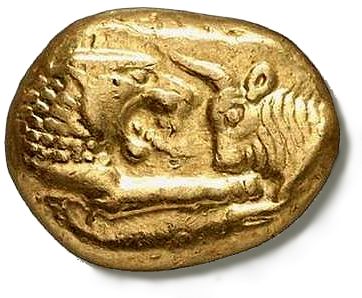
Coins have been an important part of humanity since people began settling in towns and trading with one another. Initially, a barter system was in place. But, around the 5th or 6th century BCE, coinage was introduced as a method of payment, however, the first area to use a coin is still up for debate. Bartering meant that a person would have to trade any item or service in order to get what they wanted. Unfortunately, this would not always work because if you didn't have anything that the other person wanted, then you would not be able to trade with them. According to Adam Smith, the father of modern economics, this "double coincidence of wants" of the barter system deepened as people began to specialize in specific trades. Because of this specialization, people became dependent on others to produce and provide what they could not. In addition to this problem, the barter system also made it difficult to measure the value of what was being traded. Furthermore, it was harder to preserve wealth when trading for items that could be used up within a matter of days. In order to circumvent these problems, societies created coins and currency as a medium for business. Today, we still use this system in modern societies. However, coins and currency are also seen as collectible items and as a means of investing. Below, the history of coins will be discussed along with how they were and are produced, specific designs and more. Click an era below to find out more!
________________________________________________________
The History of Ancient and Medieval Coins
The First Coins Found in the World
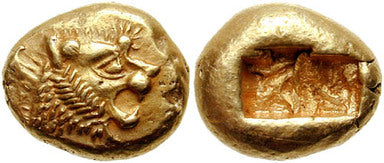
According to western history, the first coins found were in modern-day Turkey. This was known in ancient times as the Lydian Kingdom. These coins, found around 700 B.C. did not require intricate machines to be created. The coins were a naturally occurring combination of gold and silver, known as electrum. In order to make the coins stand out from any other mineral, the Lydians carved designs into one side of the coin. The other side was marked with indents. Perhaps as another means of making the currency stand out. It is speculated that the coins were weighed in order to determine their value. This makes sense as it was hard to create a consistent design for all the coins. In addition, the coins came in different shapes and sizes since they were used in their current state.
Ancient Chinese Coins
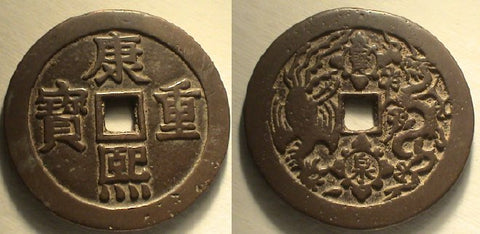
Around the same time as the Lydians, Ancient China was also creating the first known coins. However, before these coins, sea snail shells known as cowries were being used during the Shang Dynasty. Eventually, pieces of gold were used with letters of Chinese cities on them. After this, knifes of various metals were used as currency. It wasn't until around 220 BC that coin money became popular throughout the country. Most of these Chinese coins feature some sort of square or round hole. This was deliberately added so that coins could be tied to a string or wire for easier transport.
The Romans
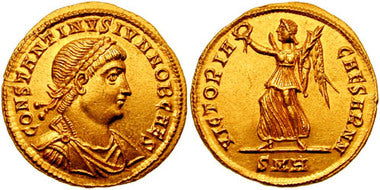
Beginning around 27 BC, the Romans developed a system where the value of the coin was worth what was stated on the coin instead of how much it weighed. This was a step towards what we call fiat money. This is what allowed the Romans to later devalue their currency by decreasing the amounts of precious metals in each coin. This devalues each coin because the coin will always say it is worth $5 dollars for example. But, if the coin goes from being 90% gold to 25% gold, then the individual is losing value in each coin. The Romans used copper, bronze, silver, and gold for their coins. Early on, the Romans had the following denominations:
400 copper coins = 100 bronze coins = 25 silver coins = 1 gold coin(1/40 lb. of Gold, then 1/50 lb. of Gold) (27 B.C. - 212 A.D.)
1000 debased metal = 40 bronze coins = 10 silver coins = 1 gold coin(1/60 lb. of Gold) (294 - 312 A.D.)
180 bronze coins = 24 silver coins = 1 gold coin(1/72 lb. of Gold) (312 A.D. Onward)
_______________________________________________________________
The History of the Industrial Era Coins
Hammered Coins

In ancient times, up until the 1550 AD, the process of creating coins involved striking a piece of metal between two dies. This process, known as "hammered coinage", was a slow process that sometimes required 2 people, one to hammer and one to hold the dies in place. Eventually, sheets of metal of the correct diameter were used to create multiple coins at once. This was used to meet the rising demand of coins used in business transactions. Unfortunately, this process created a few problems. Trying to create multiple coins at once made the coins more generic. This led to the easier counterfeiting of coins. This is because none of the coins were the exact diameter that they were supposed to be. Furthermore, the coins were not perfectly round. This allowed for the edges of the coins to be clipped of precious metals. This is why another method was needed. However, it wasn't until the renaissance and the industrial era that the technology was available to invent a better method.
Casting Coins
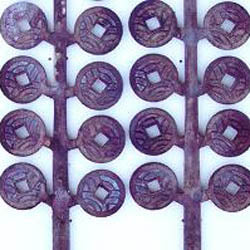
Casting coins is the process of pouring melted metal into a pre-made mold. This process was an alternative to creating coins during ancient times. It was used mostly in Asia. This method was more beneficially than the "hammering method" because up to a dozen coins could be created from one mold as opposed to just one per strike. In addition, cleaner, more refined coins were produced which prevented fraudulent coins and removing of slivers of precious metals from coins.
Milling Coins

During the Industrial Revolution, "milled coinage", or "milled edge coins", became mainstream. Also known as machine-struck coinage, this process simply means creating coins using a machine. During the industrial revolution, the Watt steam engine was created. This steam engine was used in all facets of manufacturing businesses. As more and more people went to work in factories, the need for more coins became much greater. This is when an investor known as Matthew Boulton used the steam engine to power a coin-making machine. Eventually, this led to a contract to mint coins for the East India Company, and another contract to supply machines to the British Royal Mint.
_________________________________________________________________
Coins in the Modern World
Collecting Coins

Throughout time, people have been attracted to the shiny, special allure of coins. In the modern era, there are several people who collect coins simply because they like them. There are various coins that commemorate special events or people or organizations. When news of these coins is released, there are several people who line up to ensure they can get their piece of history. Regardless of an individual's budget, there is something available for everyone that is looking start a coin collection. Whether it is an annual proof set or a rare gold coin, there is a multitude of options available for the modern collector.
Coins as an Investment

Today, people see coins as more than just a means of doing business or as something to collect. As stocks have become more and more popular in the last 150 years, the concept of investing in coins has followed suit. People are able to obtain coins for either their numismatic value or their precious metal content. The gains that an individual can get from looking at the precious metal content is obvious. The market prices of gold, silver, and other metals can be measured against what you would be getting from a specific coin. The other aspect, numismatic investing, is a little bit trickier. There are various factors to consider when investing in a coin. Aspects such as the coin, the date, grade, design, mintage and overall likability of the coin can affect the value.
The Metal Content in Coins Today

Many of the coins used in modern society today contain little to no silver or gold. A good example of this is the Kennedy Half-Dollar used in the United States. It was first created in 1964 as a tribute after President Kennedy was assassinated. The coin was composed of 90% silver and 10% copper. The next year, the silver content was reduced to about 40% silver. Eventually, all silver was removed from the Half-Dollar in 1971. This is just one example of what has happened to several U.S. coins throughout the years. The government realized that the precious metal content became more valuable than what the coin's face value stated. This is why the contents of U.S. coins have changed over the years. Another example of this is the penny. It is a common misconception that the U.S. penny is copper. Ever since 1982, coins are now 97.5% zinc and 2.5% copper. Before, they were 95% copper and 5% tin and zinc. The melt value of these older pennies is 0.0144. This means that people could theoretically get more value, albeit small, by melting these pennies for their copper content.